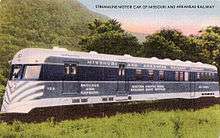Missouri and North Arkansas Railroad
The Missouri and North Arkansas Railroad was a regional carrier from 1906 to 1946, which at its peak strength joined Joplin in southwestern, Missouri with Helena in Phillips County in eastern Arkansas.
Few railroads experienced more misfortunes than the M&NA: storms, economic difficulties, labor problems, rough topography, and numerous fires. Ultimately, the company failed because Its service territory could not produce the revenue essential to the support of the railroad. The M&NA faced regional competition from two routes of the Missouri Pacific Railroad. Poor rail construction led to infrastructure failures during times of flooding. The M&NA was initially launched as a connection from Seligman in Barry County in southwestern Missouri, located on the St. Louis–San Francisco Railway, popularly known as the "Frisco".[1]
Origin
In 1883, Powell Clayton, who served as governor of Arkansas from 1868 to 1871, became the chief promoter of another railroad, the Eureka Springs Railway,[2] which serviced the resort community of Eureka Springs in Carroll County in northwestern Arkansas. As earnings for the Eureka Springs Railway proved insufficient, interest focused on servicing the zinc and lead mines of north central Arkansas. In 1899, the Eureka Springs Railway was merged into another line, the St. Louis and North Arkansas Railroad. This new company brought service to Harrison in Boone County in 1901 and Leslie in Searcy County in 1903. It planned to link to the capital city of Little Rock in Pulaski County along what became U.S. Route 65. In 1906, the railroad underwent reorganization, and the Missouri and North Arkansas Railroad Company emerged as a result.[1]
In 1908, M&NA service was extended northward to Neosho in Newton County, Missouri, and then linked with nearby Joplin through the leasing of track of the Kansas City Southern Railway. That same year, expansion proceeded southward expansion to Searcy in White County, Arkansas. By the end of 1908, the M&NA was in operation from Joplin to Kensett, also in White County. It functioned as a link from the KCS to the north and to still another line, the St. Louis, Iron Mountain and Southern Railway, popularly called the "Iron Mountain", which served central Arkansas. The M&NA was finally completed to Helena at a construction cost of $6 million. As of March 1, 1909, service had been instituted over the entire M&NA route. For a time there was limited Pullman sleeping car availability on the line. Because the M&NA was frequently late, some joked that its initials really stood for "May Never Arrive". After repeated deficits, the railroad entered receivership in April 1912.[1]
History
In 1913, the main office and shops of the M&NA were located in Harrison, Arkansas. Though the railroad was by then in first-class condition, a head-on collision caused by faulty communication occurred in August 1914 near Tipton Ford in Newton County, Missouri. Thirty-eight passengers and five crew members were killed. The takeover of the M&NA by the United States Railroad Administration during World War I cost the company dearly. Then a bitter wage strike, with resulting vandalism, occurred in 1921, and the railroad ceased operations for eight months. Reorganized in April 1922, it resumed operations and began to turn a profit despite lingering labor troubles.[1]

Prosperity seemed near when the Great Mississippi Flood of 1927 damaged much of the rail infrastructure in eastern Arkansas, and for a second time, the M&NA entered into receivership. In 1935, the Missouri and Arkansas Railway Company was established and assumed the previous M&NA property. In December 1941, the general offices of the M&NA at Harrison were destroyed by fire, and the shops burned a few months later. During World War II, tonnage increased and revenues improved, but another strike over wages and another fire created renewed havoc. Then in 1945, the White River near Georgetown in White County overflowed its banks. There was a rapid decline in postwar business, and the M&NA ceased operations in September 1946.[1]
In 1949, two sections of the former Missouri and Arkansas Railway Company returned to service under new ownership. That section from Seligman to Harrison was operated from 1950 to 1960 by the diesel-powered Arkansas and Ozarks Railway. The route from Helena to rural Cotton Plant in Woodruff County, Arkansas, operated with steam equipment from 1949 to 1951 as the Helena and Northwestern Railway. A six-mile link of the Helena and Northwestern from Cotton Plant to rural Fargo in Monroe County was operated by the Cotton Plant-Fargo Railway, which joined with the St. Louis Southwestern Railway, popularly known as the Cotton Belt. This short line existed from 1952 into the 1970s, when it became the last portion of the old M&NA to be abandoned.[1]
Among the absentee owners of the M&NA was Frank Kell, the entrepreneur from Wichita Falls, Texas, who was also affiliated with the Wichita Falls and Northwestern Railway, Wichita Falls and Southern Railroad, and the San Antonio, Uvalde and Gulf Railroad.[3]
References
- 1 2 3 4 5 6 "H. Glenn Mosenthin, "Missouri and North Arkansas Railroad"". encyclopediaofarkansas.net. Retrieved April 28, 2013.
- ↑ Not to be confused with the Eureka Springs and North Arkansas Railway
- ↑ ", J. W. Williams, "Kell, Frank"". The Handbook of Texas. Retrieved April 28, 2013.
